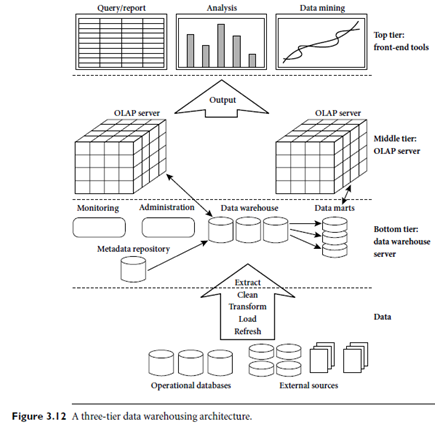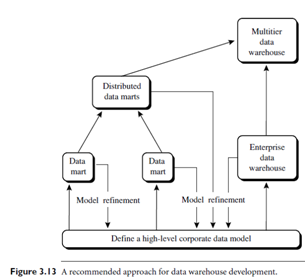A Three-tier Data Warehouse Architecture
Introduction: Three tier client server architecture is also known as multi-tier architecture and signals the introduction of a middle tier to mediate between clients and servers. The middle tier exists between the user interface on the client side and database management system (DBMS) on the server side. This third layer executes process management, which includes implementation of business logic and rules. The three tier models can accommodate hundreds of users. It hides the complexity of process distribution from the user, while being able to complete complex tasks through message queuing, application implementation, and data staging or the storage of data before being uploaded to the data warehouse.

1. The bottom tier is a warehouse database server that is almost always a relational database system. Back-end tools and utilities are used to feed data into the bottom tier from operational databases or other external sources (such as customer profile information provided by external consultants). These tools and utilities perform data extraction, cleaning, and transformation (e.g., to merge similar data from different sources into a unified format), as well as load and refresh functions to update the data warehouse (Section 3.3.3). The data are extracted using application program interfaces known as gateways. A gateway is supported by the underlying DBMS and allows client programs to generate SQL code to be executed at a server. Examples of gateways include ODBC (Open Database Connection) and OLEDB (Open Linking and Embedding for Databases) by Microsoft and JDBC (Java Database Connection). This tier also contains a metadata repository, which stores information about the data warehouse and its contents. The meta data repository is further described in Section 3.3.4.
2. The middle tieris an OLAP server that is typically implemented using either (1) a relational OLAP (ROLAP) model, that is, an extended relational DBMS that maps operations on multidimensional data to standard relational operations; or (2) a multidimensional OLAP (MOLAP) model, that is, a special-purpose server that directly implements multidimensional data and operations. OLAP servers are discussed in Section 3.3.5.
3. The top tieris a front-end client layer, which contains query and reporting tools, analysis tools, and/or data mining tools (e.g., trend analysis, prediction, and so on).
From the architecture point of view, there are three data warehouse models: the enterprise warehouse, the data mart, and the virtual warehouse.
- Enterprise warehouse:An enterprise warehouse collects all of the information about subjects spanning the entire organization. It provides corporate-wide data integration, usually from one or more operational systems or external information providers, and is cross-functional in scope. It typically contains detailed data as well as summarized data, and can range in size from a few gigabytes to hundreds of gigabytes, terabytes, or beyond. An enterprise data warehouse may be implemented on traditional mainframes, computer super servers, or parallel architecture platforms. It requires extensive business modeling and may take years to design and build.
- Data mart:A data mart contains a subset of corporate-wide data that is of value to a specific group of users. The scope is confined to specific selected subjects. For example, a marketing data mart may confine its subjects to customer, item, and sales. The data contained in data marts tend to be summarized. Data marts are usually implemented on low-cost departmental servers that are UNIX/LINUX- or Windows-based. The implementation cycle of a data mart is more likely to be measured in weeks rather than months or years. However, it may involve complex integration in the long run if its design and planning were not enterprise-wide.
- Depending on the source of data, data marts can be categorized as independent or dependent. Independent data marts are sourced from data captured from one or more operational systems or external information providers, or from data generated locally within a particular department or geographic area. Dependent data marts are sourced directly from enterprise data warehouses.
- Virtual warehouse:A virtual warehouse is a set of views over operational databases. For efficient query processing, only some of the possible summary views may be materialized. A virtual warehouse is easy to build but requires excess capacity on operational database servers.

- The pros and cons of the top-down and bottom-up approaches to data warehouse development” The top-down development of an enterprise warehouse serves as a systematic solution and minimizes integration problems. However, it is expensive, takes a long time to develop, and lacks flexibility due to the difficulty in achieving consistency and consensus for a common data model for the entire organization. The bottom-up approach to the design, development, and deployment of independent data marts provides flexibility, low cost, and rapid return of investment. It, however, can lead to problems when integrating various disparate data marts into a consistent enterprise data warehouse.
- A recommended method for the development of data warehouse systems is to implement the warehouse in an incremental and evolutionary manner, as shown in Figure 3.13. First, a high-level corporate data model is defined within a reasonably short period (such as one or two months) that provides a corporate-wide, consistent, integrated view of data among different subjects and potential usages. This high-level model, although it will need to be refined in the further development of enterprise data warehouses and departmental data marts, will greatly reduce future integration problems. Second, independent data marts can be implemented in parallel with the enterprise warehouse based on the same corporate data model set as above.
- Third, distributed data marts can be constructed to integrate different data marts via hub servers. Finally, a multitier data warehouse is constructed where the enterprise warehouse is the sole custodian of all warehouse data, which is then distributed to the various dependent data marts.